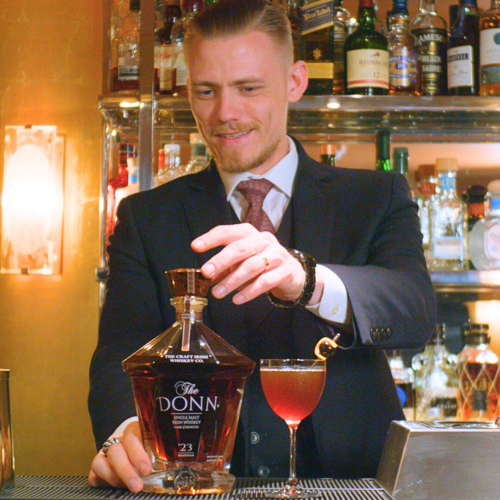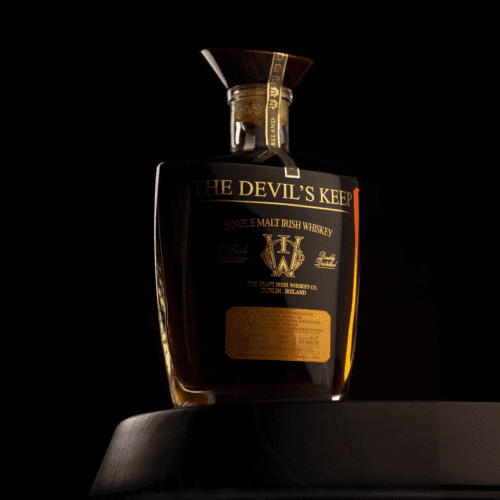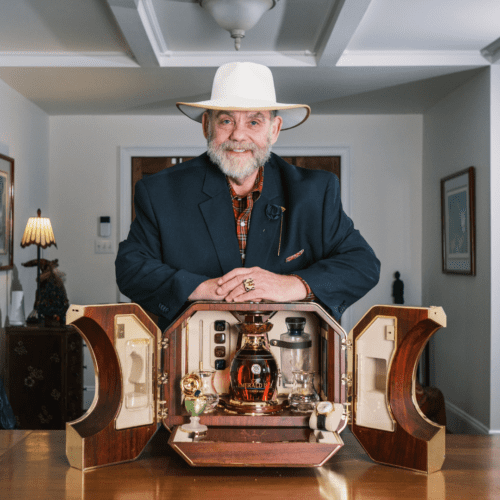We hear it said all the time: age is just a number. But the phrase is never more apt than when we’re talking about whiskey. Even though “age statements” are all the rage among a certain set of whiskey collectors, the real connoisseurs understand that great whiskey—be it Irish whiskey or Scotch single malt—is built around flavour, not the number on the bottle. And often there is no strong connection between the two. Which is precisely why we don’t believe in age statements. We are building towards absolute greatness, not some arbitrary threshold.
The proof is in the international acclaim. Earlier in 2022, The Craft Irish Whiskey Co. won world’s Best Irish Single Malt at the World Whiskies Awards. The honour was bestowed upon The Devil’s Keep—a stunning expression of liquid that founder and CEO Jay Bradley opted to pull from the cask after 29.9 years worth of maturation. It was just shy of the 30-year-mark, which many brands would love to brandish on a bottle.
Who could blame them? Look at any Scotch or Irish whiskey wearing a 30-year-old age around its collar and you’ll be hard-pressed to find anything under the 4-figure price tag. But for Bradley, it was all about excellence. He was carefully pulling samples of his beloved liquid each day as the expression matured in a finish of fine Hungarian Oak. Then came the day when it was just right for bottling. If he kept it in the barrel longer, he could have chased that 30-year mark, but the whiskey wouldn’t have been as good.
Again, age is just a number. And a good indicator of how much oak influence will be in the whiskey it represents. Quite frequently there can be too much of that influence. When it comes to wood, you most certainly can have too much of a good thing. Age-statement hunting whiskey fans overlook this key fact.
Even more, they are overlooking the science that shows whiskey peaks and troughs repeatedly throughout its ageing process. As a dedicated student of the category, Bradley discovered this reality and plotted it out on a chart across cask maturation. A standout whiskey, he determined, can be great in one moment—say spring—and fall-off by summer of that same year. And so the only way to arrive at an exceptional product is through quality barrels and intense and precise organoleptic observation; that is, tasting it frequently as it sits in the warehouse (not a bad vocation, we know).
“I am ecstatic and equally humbled that The Devil’s Keep was crowned World’s Best Irish Single Malt, beating some fantastic competition including two stellar whiskeys from the Teeling stable”, said Bradley after winning the prize. “After years of research devoted to building more flavour into our whiskeys, The Devil’s Keep is the culmination. And this accolade reinforces to me that what we are doing is working and that the critics and experts are enjoying what we are creating. We have so much more to do and winning this award makes me hungrier than ever to keep this momentum going and to bottle more phenomenal whiskeys.”
The critical recognition of The Devil’s Keep is just one meaningful validation in the case against age statements. The 2020 Inaugural Edition of the Irish Whiskey has actually collected nine awards so far. But the list goes on and on. Take a look at the list of best whiskeys at any awards. The top prizes will quite regularly be taken home by bottles that wear no age on their respective labels. In fact, at the same World Whiskies Awards, the title of World’s Best Single Malt across all categories went to another non-age-statement entry: The Lakes Single Malt Whiskymaker’s Reserve No.4. That’s not to say there aren’t fantastic bottlings out there at 50, 60, even 70 years in age. It’s just a reminder that those lengthy ages do not necessarily equal outstanding tasting scores.
A great way to prove it to yourself is to do a comparative tasting, blind. With a group of other whiskey enthusiasts, pour out a few drams of your preferred liquids—some with age statements and some without. See how you rank them, freed from the preconceived notion that older is better.
Remember that the age statement merely reflects the youngest liquid in the blend. And so if you’re tasting a whiskey that is “20 years old” it could actually contain just a drop of 20-year-old liquid within a sea of 40 year old spirit. Most blenders would never do something like that because why would you cannibalise the potential value of your release by bringing out something that must be marketed and sold as a younger aged whiskey?
Well the answer is, that final blend might taste better with the vibrancy of that particular 20-year-old in the mix. What we have found as experts—as both whiskey makers and whiskey drinkers—is that when a producer or blender is able to combine stock as they see fit, without being beholden to arbitrary age thresholds, they usually come away with something superior.
Age is just a number. And it’s not nearly as impressive as some would have you believe. If you’re looking for a truly impressive number, check out what The Devil’s Keep is now selling for at auction. The most expensive inaugural first release in Irish whiskey history is now valued at over $60,000 a bottle. That’s what we call a meaningful statement of excellence!










